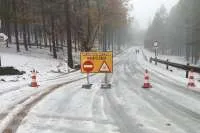Two new traffic signs being tested in Canary Islands to improve road safety
- 11-10-2024
- National
- DGT - Trafico
- Photo Credit: DGT
The Spanish Directorate General of Traffic (DGT) have introduced two new experimental road markings in the Canary Islands: ‘Dragon’s Teeth’ and Broken Edge Lines. These measures, aimed at increasing road safety in critical sections, are relatively unknown to many drivers.
The signs are intended to warn drivers of approaching high-risk areas, such as pedestrian crossings or dangerous junctions, to ensure safer driving conditions, especially in urban areas and near schools.
Dragon’s Teeth
Dragon’s Teeth are triangular markings painted on the road, designed to alert drivers to reduce speed as they approach pedestrian crossings or dangerous intersections. The triangles are placed just before these areas, with their sharp shape resembling teeth, hence the name.
Broken Edge Lines
Broken Edge Lines are zig-zag markings at the side of the road that indicate no parking or stopping is allowed in the designated area. Their primary purpose is to improve visibility and prevent obstructions, particularly in curves or areas with limited visibility. These lines help maintain clear sightlines, enhancing safety in high-traffic or pedestrian-heavy zones.
These experimental measures are part of a broader effort by the DGT to ensure road safety, particularly in urban areas. The Ministry of Transport and Sustainable Mobility notes that road markings can be perceived differently in practice compared to their design on paper, and these trial runs help assess their effectiveness and drivers’ understanding before they are officially added to the national traffic regulations.
By incorporating these new signs, authorities hope to reduce accidents and improve overall road safety in areas where caution is critical.
Other articles that may interest you...
Trending
Most Read Articles

Featured Videos
A Vision of Elvis Tenerife Promo
- 10-05-2025
TEAs 2025 Highlights
- 17-11-2025

























































